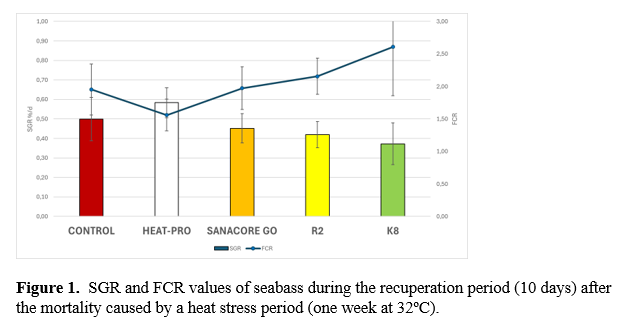BENCHMARKING OF HEALTH PROMOTING ADDITIVES TO SUPPORT HEAT STRESS TOLERANCE OF EUROPEAN SEABASS Dicentrarchus labrax
Introduction
Water temperature plays a crucial role in fish culture. In the context of climate change and extreme temperature events, the impact of increasing ocean temperature affects aquaculture production in general, and European aquaculture in particular. In the southern part of the Mediterranean, the temperature of shallow waterbodies may occasionally exceed 33–34 ◦C, especially during summer. European seabass, Dicentrarchus labrax, an important aquaculture species, is challenged with the increased frequency and intensity of heatwaves (Islam et al., 2025; Sáez-Arteaga et al., 2020) adding stress to farmed fish. Some of the strategies to mitigate thermal stress include feeding optimization, water quality control, culture density management and lately, dietary manipulations (Herrera et al., 2019). Feed additives have shown efficacy to counteract stress effects (including oxidative stress) and physiological functions in farmed fish (Zhang et al., 2020). In this study, we have done a benchmarking of different health additives to strengthen heat stress tolerance in European seabass.
Material and methods
European seabass of 144 ± 3.23 g average individual body weight was distributed in 15 tanks of a marine RAS. A group of 14 animals was stocked per tank. Water temperature was controlled during the trial: 1st week at 26ºC; 9 weeks at 28ºC, 1 week at 32ºC and 10 days at 28ºC. Temperatures changes were applied progressively at 1ºC per day until the established temperature.
Five isonitrogenous and isolipidic diets (43 % CP/16% CF) were evaluated: 1) a control diet, 2)HeatPro (Adisseo), 3) Sanacore (Adisseo), 4) R2 and 5) K8. Fish were fed manually twice per day to apparent satiation 6 days per week. Feed intake was controlled daily. The trial lasted 12 weeks. After the 9 weeks at 28ºC seabass were sampled for SGR and FCR. At the end of the trial (12 weeks), fish were sampled to calculate SGR, FCR and somatic indexes. Plasma samples were also taken for cortisol, glucose, lactate, total proteins, TAG and cholesterol determinations. Liver samples were obtained and processed for proteomic analysis, histopathological analysis and for antioxidant enzymatic analysis (MDA, CAT, SOD, GPX and pNPB).
Results & conclusions
No difference among diets were found in SGR nor FCR during the 9 weeks that the seabass was cultured at 28ºC. However, after one week at 32ºC, mortality appeared in all the fish fed the experimental diets. Seabass fed diet HeatPro diet presented the highest survival, followed by the fish fed diet Sanacore and control diet (95,24%, 92,86% and 88.10 % respectively). After the mortality episode, fish was kept in the system for 10 more days at 28ºC. Although no significant difference was found for SGR nor FCR, seabass fed diet Sanacore showed a 17% better SGR and 20% lower FCR than the fish fed the control diet (Figure 1).
Plasma metabolites showed significant differences for cortisol, glucose and lactate (lowest values for fish fed the HeatPro diet). Histopathology analysis showed that all the fish were highly affected by the temperature increase during the trial; all groups presented a marked level of intracytoplasmic lipid-type vacuolation in the liver and the high temperature may have promoted direct or indirect liver damage at subclinical level. Enzymatic antioxidant analysis pointed out that fish fed Sanacore diet had significantly lower MDA values. No difference was found for CAT, SOD, GPX or pNPB, although fish fed Sanacore showed the lowest values, except for pNPB. Molecular (stress markers) analysis of the fish fed with HeatPro diet showed reduced HSP70 and PRDX3 level, indicating lower cellular stress, and increased IGF-1 expression, reflecting improved recovery and metabolic balance.
As conclusion of the study, it can be pointed out that seabass subjected to heat stress (temperature above 30ºC) and fed HeatPro diet showed better SGR, FCR, cortisol, lactate and glucose plasma levels than the fish fed control diet. On the other hand, fish fed Sanacore diet showed significantly lower MDA values than the fish fed control diet. Molecular findings suggest that the supplementation with HeatPro enhances stress tolerance and physiological resilience in seabass under high-temperature conditions.
References
Herrera, M., Mancera, J.M., Costas, B., 2019. The use of dietary additives in fish stress mitigation: comparative endocrine and physiological responses. Front. Endocrinol. (Lausanne). https://doi.org/10.3389/fendo.2019.00447.
Islam, M.J., Hossain, A., Kunzmann, A. 2025. Salinity and dietary manipulation can ameliorate extreme summer heatwave stress in European seabass, Dicentrarchus labrax. Aquaculture, Volume 601, 742252, https://doi.org/10.1016/j.aquaculture.2025.742252.
Sáez-Arteaga, A., Viegas, I., Palma, M., Dantagnan, P., Valdebenito, I., Figueroa Villalobos, E., Hernández, Jimena Guerrero-Jiménez, A., Metón, I., Heyser,C, 2024. Impact of increasing temperatures on neuroendocrine and molecular responses of skeletal muscle and liver in fish: A comprehensive review. Aquaculture Reports, Volume 39, 102448, https://doi.org/10.1016/j.aqrep.2024.102448.
Zhang, F., Man, Y.B., Mo, W.Y., Wong, M.H. 2019. Application of Spirulina in aquaculture: a review on wastewater treatment and fish growth. Rev. Aquac. 12, 582–599. https://doi.org/10.1111/raq.12341.
